I'll definitely have to see about the 1.15 update. It looks like it has a bugfix for something I noticed, too—ships of exactly 5,000 tons have higher horsepower requirements than they otherwise ought to.
June 1906We uncover an Italian spy, pushing the issue for some extra budget.
July 1906Britain is working hard to win the new dreadnought race. In addition to their one completed dreadnought, they have four more under construction, along with two battlecruisers.
August 1906Tensiosn with Germany continue to decrease. I think we might have turned the corner on that crisis.
September 1906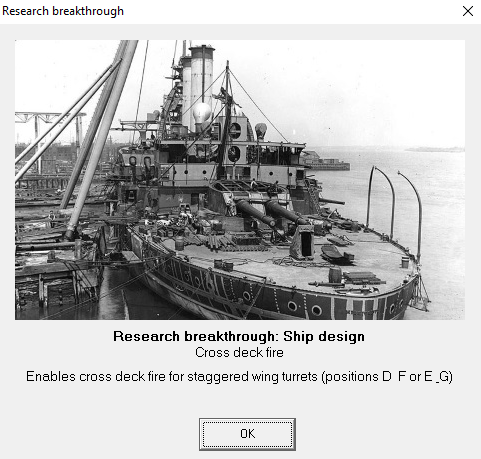
A new technology allows us to plausibly design eight- or ten-gun battleships even with our current three-centerline-turret limitation.
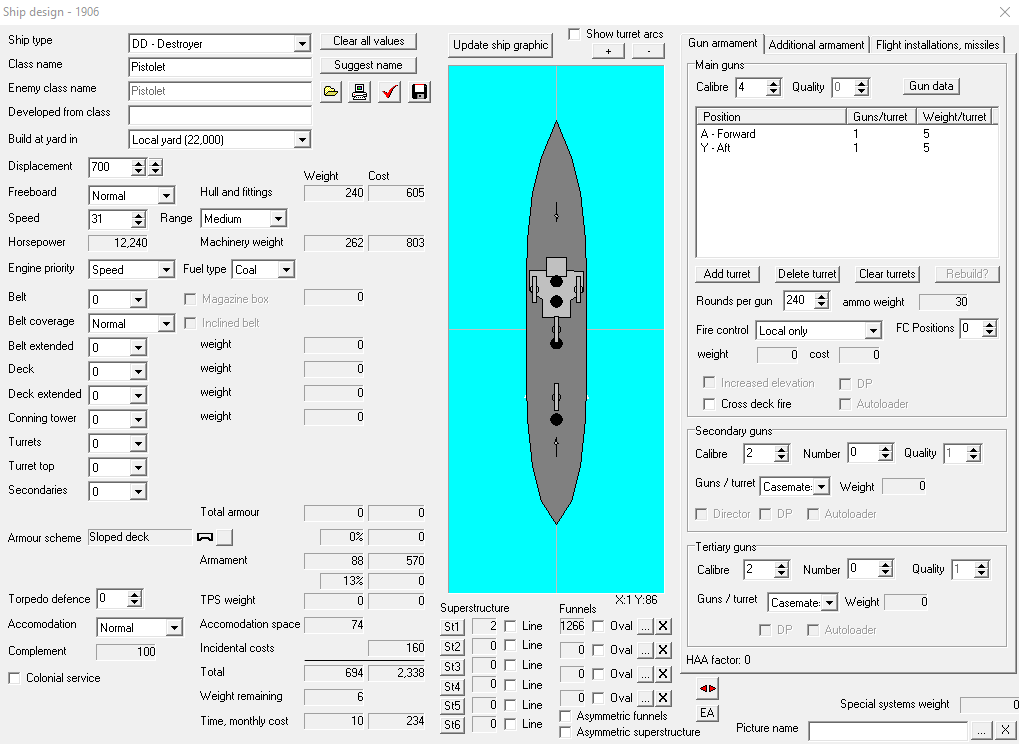
Improved engine technology and doctrinal allowances for 700-ton destroyers let us design our best class yet, with two guns, four torpedo tubes, and 31-knot speed.
October 1906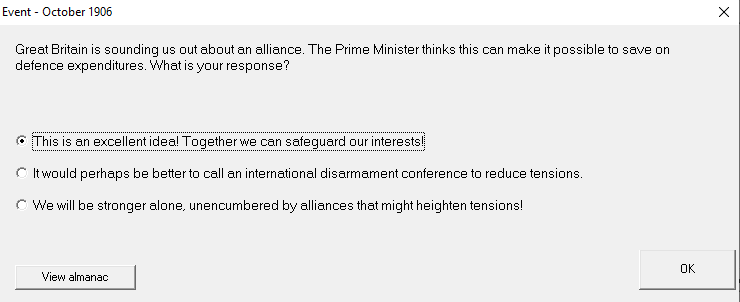
A historical friend of ours comes calling. We say 'oui', and I think this calls for pushing for another war with Italy.
November 1906Speaking of which...
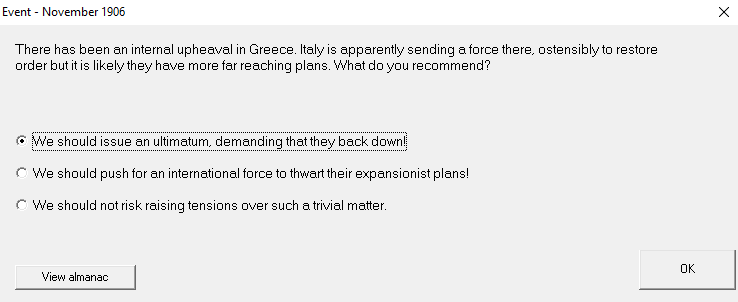
War breaks out. The first battle is a cruiser action where darkness and poor weather guarantee the fleets pass one another in the night.
In addition to the three
Duquesne battlecruisers, one
Isly light cruiser, and five
Pistolet destroyers on the ways, I queue up six corvettes and two armed merchant cruisers equipped with mines, to help take the pressure off of the fleet.
December 1906Two days before Christmas, three French light cruisers (an
Isly and two
Tages) supported by a destroyer flotilla embark on a raid on coastal shipping. They'll arrive south of La Spezia near dusk, doglegging a bit south to hopefully avoid any patrolling Italian ships.
At 2 p.m., the French squadron sights the northern end of Corsica and turns east.
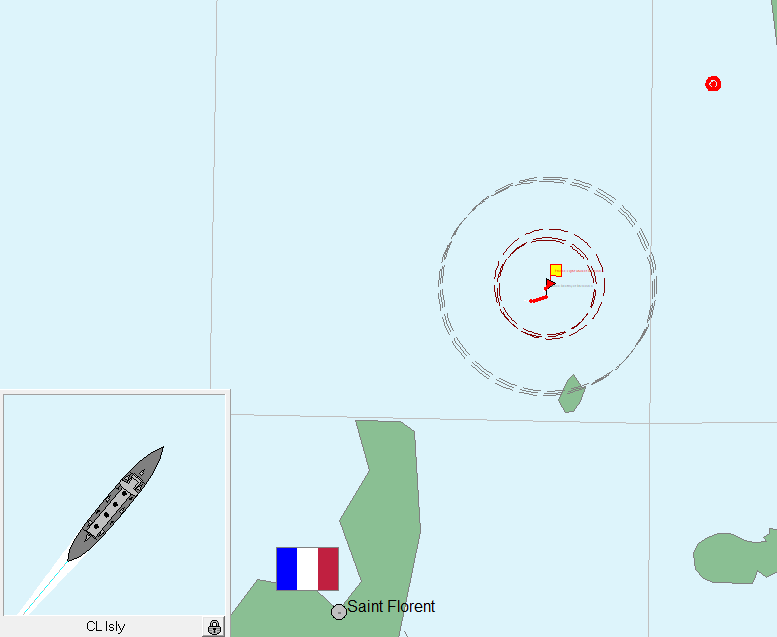
Just after 4 p.m., the squadron sights one ship moving west-northwest at warship speeds, and turns northwest in pursuit. Another appears on the horizon to the northeast.
At 4:30 p.m.,
Isly's crew spots a line of three ships due north of the squadron, probably armored cruisers. The enemy line turns toward the French squadron just as the sun dips below the horizon, and the French ships elect to make a daring run toward the Italian coast, hoping to search out and sink a coastal merchant or two during the night.
The decision pays off, as the French squadron runs across two transports in quick succession, sinking them both.
Isly and
Lalande combine to take down the first one, while a torpedo from
Isly sinks the second, as its crew flees in small boats.
The job done, the French squadron rings up flank speed and dashes for the Riviera. A major victory for France nets us 968 victory points.
January 1907On the 28th, two Italian cruisers come across a French Atlantic convoy, facing off against
Linois (a
Tage-class light cruiser) and a pair of
Fauconneaus. The weather is clear, but it's 4:41 p.m., so the Italian squadron has a limited time during which it can press its attack without attracting torpedo fire in reply.
Confused night fighting sees the loss of both destroyers, but
Linois survives and drives off the armored cruisers before they can sink very many freighters. In ship losses, the Italians are the clear victors, but because so much of the convoy survived, it goes in the books as a minor French victory.
February 1907The Italians put out peace feelers, amusingly. I instruct the government to put the screws to them, and negotiations stall.
After a quiet first few months, French raiders come through in a big way, sinking eleven merchants to the Italians' 2.
On the 25th, two French light cruisers and a squadron of the newer
Francisque destroyers chance upon an Italian convoy southeast of Malta, and sink four transports before fleeing in the face of a superior Italian escort. The objective being
six transports, it goes down as a French loss. I disagree, but what are you going to do?
March 1907This month, it's a convoy defense.
Isly and a pair of
Tage-class light cruisers drive off an attack from a similar Italian force. They probably could have defeated the Italians outright, but crews aboard our destroyers misidentified one of their light cruisers as an armored cruiser.
April 1907Troude, a
Tage-class cruiser, rather embarrassingly fails to destroy a bombardment target in Eritrea despite emptying her entire magazine into it.
May 1907On the 11th, the Italians launch a raid on our coastal facilities. The fleet sorties.
The Battle of NiceVisibility is good, the weather is pleasant, and we're in that part of the year where the days are the longest. It's looking good for something decisive.
 5:21 a.m.
5:21 a.m.The French fleet sights the Italian fleet to the west, and turns to engage.
6:00 a.m.Together, the Italian fleet turns away from the French. We give chase.
6:44 a.m.Sighting the Italian armored cruisers to the north, we ditch the battleships for now, on the theory that a stern chase is a long chase, and we have the speed to catch the cruisers against the French coast.
 4:57 p.m.
4:57 p.m.It works. Although the Italian battle line escapes more or less unscathed, three Italian armored cruisers now dot the bottom of the Mediterranean Sea. The only French loss is the light cruiser
Lalande, torpedoed by an enemy submarine as we steam back to port.

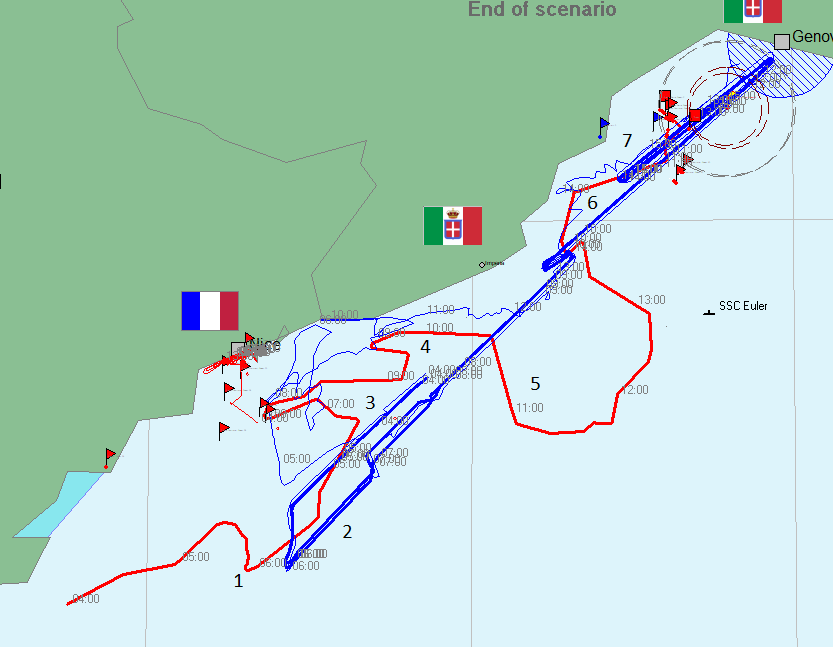
I'm going to recommend zooming in a bit on this one. It's a busy picture. I've put some numbers on it to guide you through the battle.
At 1), the French fleet spots the Italian, and turns to go broadside to broadside. The sharp turn indicates when the Italians began to run.
At 2), the French fleet turns north after the enemy armored cruisers, and at 3), we drive them up against the coast.
West of 3), the Italian cruisers scatter. We pursue a pair of them up to 4), heavily damaging two of them. One, an
Amalfi-class, is dead in the water, and destroyers torpedo it until it sinks. Another, also an
Amalfi-class, slinks away up the coast, harangued by light forces until I recall them to screen the battle line.
They get recalled because the fleet spots one more Italian cruiser at 5), this one a slower
Carlo Alberto type. One or two heavy hits slow it further, so that the battle line can fully catch up. Eventually, the vastly heavier weight of gunfire tells, and it slips beneath the waves at around 13:00.
From that point to 6), the fleet stands to the northwest, in pursuit of the
Amalfi which escaped back at 4), coming across it and engaging it further. The brief French turn southwest, near 6), corresponds to the brief Italian sally at 7). After they lose heart, we resume our chase of the
Amalfi, ultimately sinking it just before the minefields at Genoa.
It counts as a major victory, which earns us +1 prestige.
June 1907The Italian navy declines battle over a large French convoy in the Mediterranean, and has no forces in the Indian Ocean to defend against a coastal raid conducted by a French cruiser squadron.
July 1907An Italian submarine torpedoes the light cruiser
Lavosier, a
Chateaurenault. Two Italian light cruisers attack a French convoy, opposed by a pair of
Tages and five destroyers. Though the French squadron took heavier damage than the Italian one did, the convoy escapes unscathed.
The first
Duquesne-class battlecruiser enters service. It'll need a month or two to finish working up before we can send it to the Mediterranean.
Design studies on the first French dreadnought battleship are finished now. In thirty months,
Devastation will come down the ways.
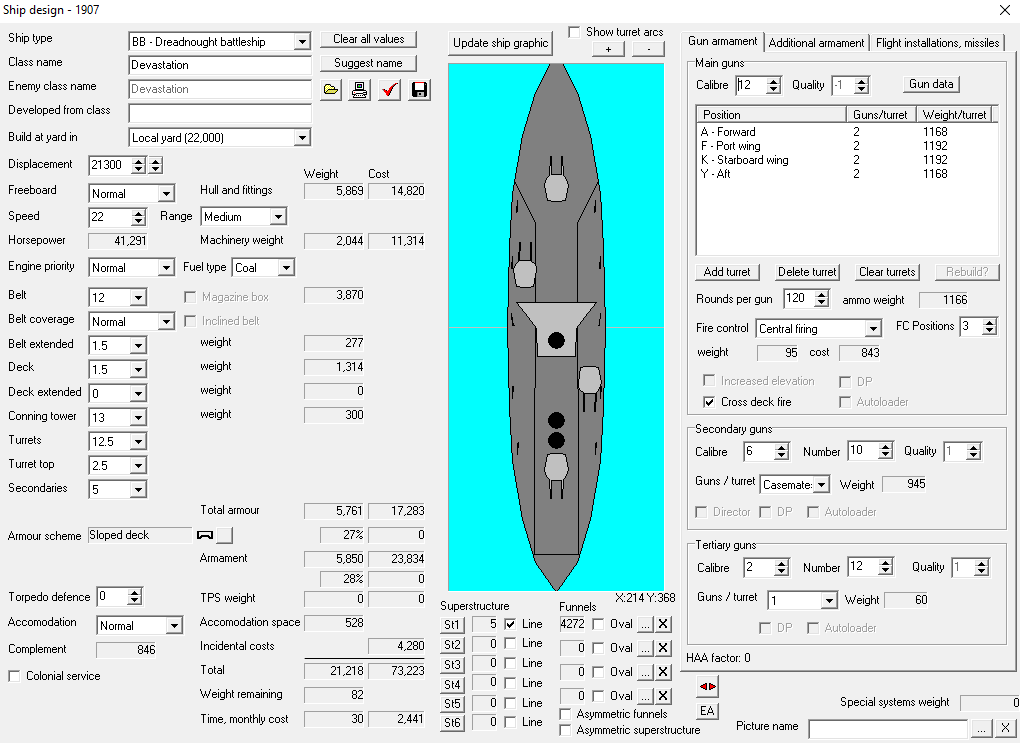 August 1907
August 1907Getting vengeance for
Lavosier is our submarine
Euler, which torpedoes and sinks the Italian light cruiser
Nino Bixio.
On the morning of the 27th, three
Tage-class cruisers and a screen of six destroyers set out for the Italian coast, in search of coastal shipping. The weather is breezy and overcast, but visibility is good.
They sink a pair of ships merchants, managing to evade a pair of patrolling Italian armored cruisers by a daring run nearer the coast.
September 1907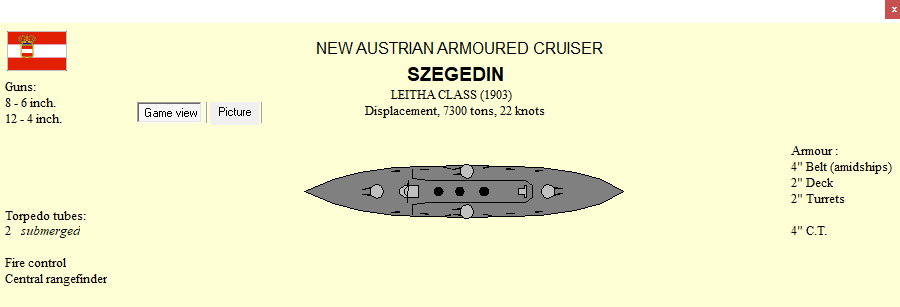
The Austrians are building a very obsolete armored cruiser.
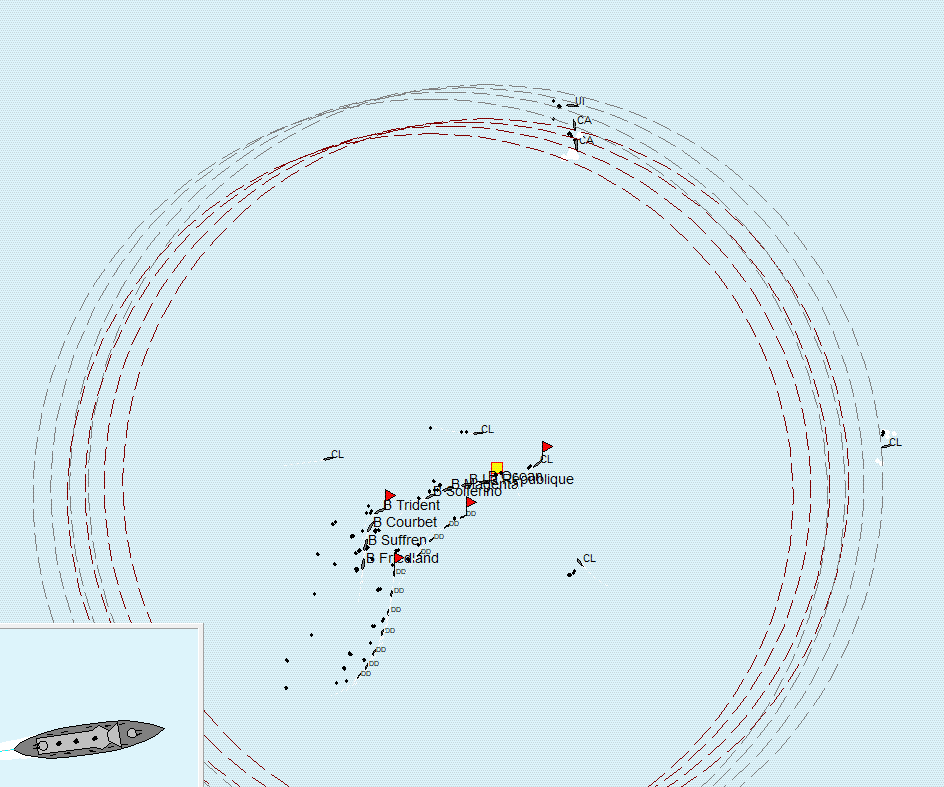
The French and Italian fleets collide near Nice, very briefly, before twilight intervenes. During the attempted pursuit,
Fronde, a
Francisque-class destroyer, strikes a mine and sinks. The fleet quickly abandons the chase, and the Italians notch a very marginal victory.
October 1907
The Italians have an interesting semi-dreadnought in the works, approximately similar to our
Tridents, if a bit slower and much more heavily armed.
Duquesne and
Jean Bart (the latter another
Isly light cruiser) finish working up, and will be heading to the Mediterranean for a November arrival. Or, as I think about it, they will instead stay in northern Europe on trade protection duty, where they might run across some of the Italian armored cruisers raiding our shipping in that region.
Three
Tage-class cruisers raid the Italian coast, this time destroying two merchantmen while fleeing from an Italian fleet headed by one of their 22-knot
Amalfi-class armored cruisers. (Sure am glad our ships are fast!)
November 1907At around 2 p.m. on the 8th, under cloudy skies and a moderate breeze out of the southwest, scouting units of
la Marine Nationale spot an unknown vessel sailing toward Nice. The fleet turns that direction.
3:28 p.m.The Italian fleet, predictably, is running to the west. This time, we have a few hours of daylight, so the battle line pours on some speed and tries to get downwind of the Italians, so as to avoid having to shoot with smoke in our eyes.
4:36 p.m.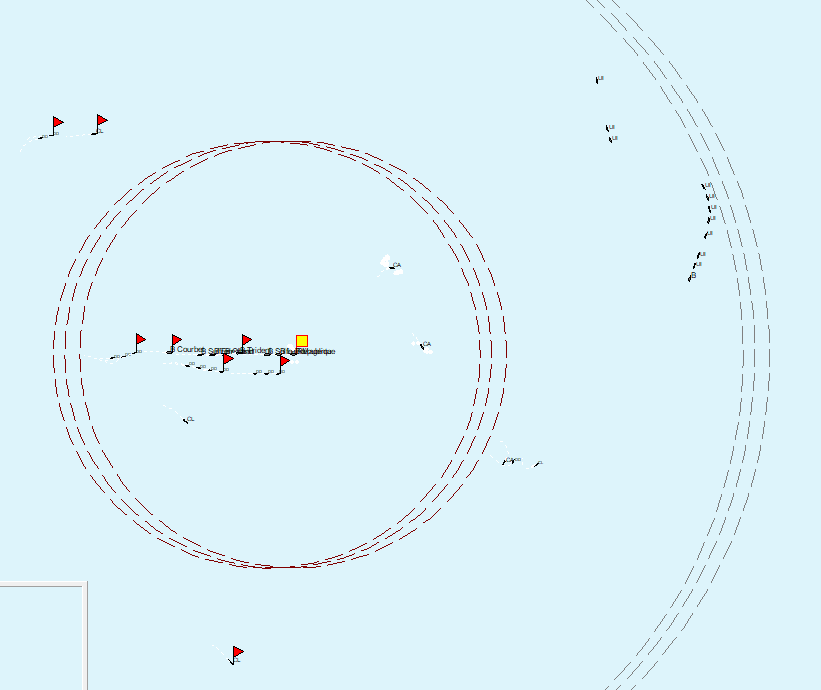
The Italian battle line comes into view, twelve miles to the east-northeast, heading northwest. We'll see if we can't bag a few of these cruisers again; it doesn't look like the battleships are going to stick around to play.
4:57 p.m.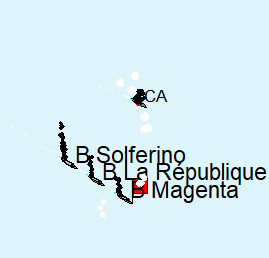
This
Carlo Alberto may be a decent armored cruiser. It is not, however, a match for three battleships.
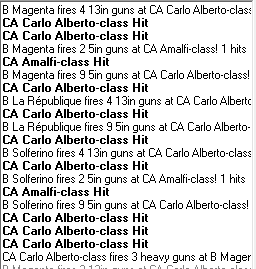
At this range, even our inept gunners can hardly miss.
5:29 p.m.
The Italian battle line returns as twilight settles in. Soon it'll be dark; perhaps we'll be able to run down the
Amalfi-class cruiser in front of us.
5:57 p.m.Night falls. The French fleet takes a northward turn, with an eye toward catching some of the enemies in close and setting the destroyers on them.
7:15 p.m.The opposite happens;
Magenta and
La République eat a torpedo a piece. Adroit damage control keeps them afloat, limping back to Nice for patching up.
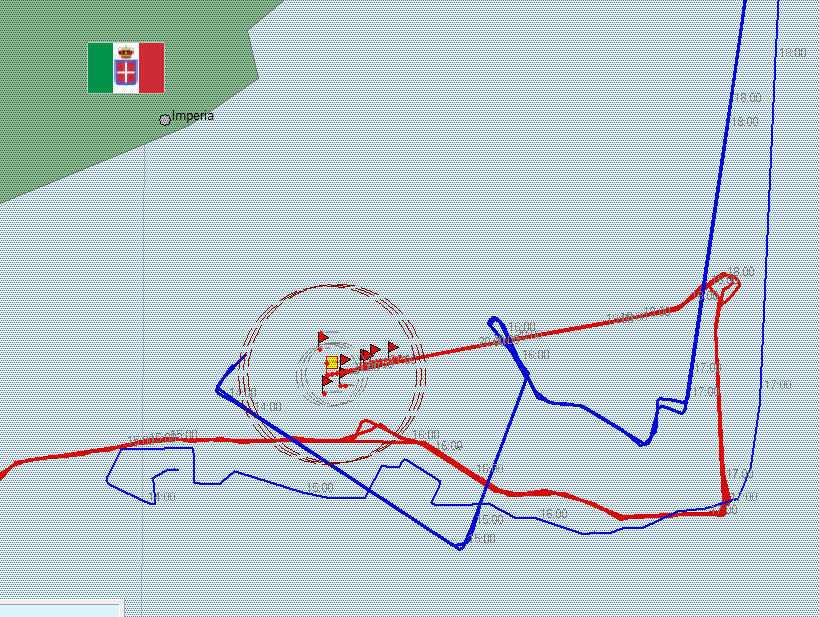
This battle was a bit simpler, and doesn't need the explanatory numbering. You can se how the French fleet generally kept to the north of the Italian cruisers, and how, to my surprise, the Italian battleships were
south of our ships for much of the action, only turning across our bow at about 3:00 p.m. When I first caught sight of them, it was toward the end of that maneuver.
November 1907, cont'd.The victory point totals stand at 12,096 for the good guys to 4,438 for the Italians.
December 1907On the 22nd, the Italians attack a French convoy. I had hoped that
Duquesne, dispatched to the Mediterranean in pursuit of the Italian armored cruisers formerly of the North Atlantic, would play a role, but alas, she does not. Instead, three
La Républiques take to the sea. It turns into a running gun battle that lasts until nightfall—three French battleships (then two, after
Friedland took a hit which damaged her engines) against four Italian, plus two Italian armored cruisers.
Surprisingly, the French ships acquitted themselves well—all three battleships took light damage, inflicting light damage in return on two battleships, and medium damage on the two Italian cruisers.
Intelligence indicates that the next-generation German dreadnought has 16" belt armor—impressive, and four inches thicker than our upcoming
Devastation. A quick look at Britain's dreadnoughts suggests that Germany is an outlier in the direction of heavier protection.
January 1908The Italians put out peace feelers again. The Navy recommends that we squeeze them as hard as we can, and...
 Unfortunately, the 'considerable war reparations' appear to be for flavor.
Unfortunately, the 'considerable war reparations' appear to be for flavor.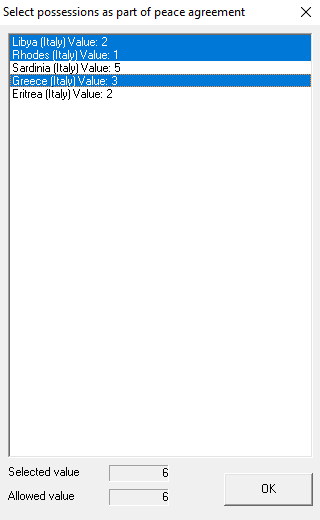 Large territorial gains, though...
Large territorial gains, though...Unlike the last one, this war bears fruit. While Sardinia would have been a sweet apple to pluck, I decide instead to build a belt of bases around Italy (and, for that matter, Austria).
Finally, with an eye toward retiring some of the
Gueydons and mothballing others until such time as naval aircraft are invented, I start on an overseas-service light cruiser design.
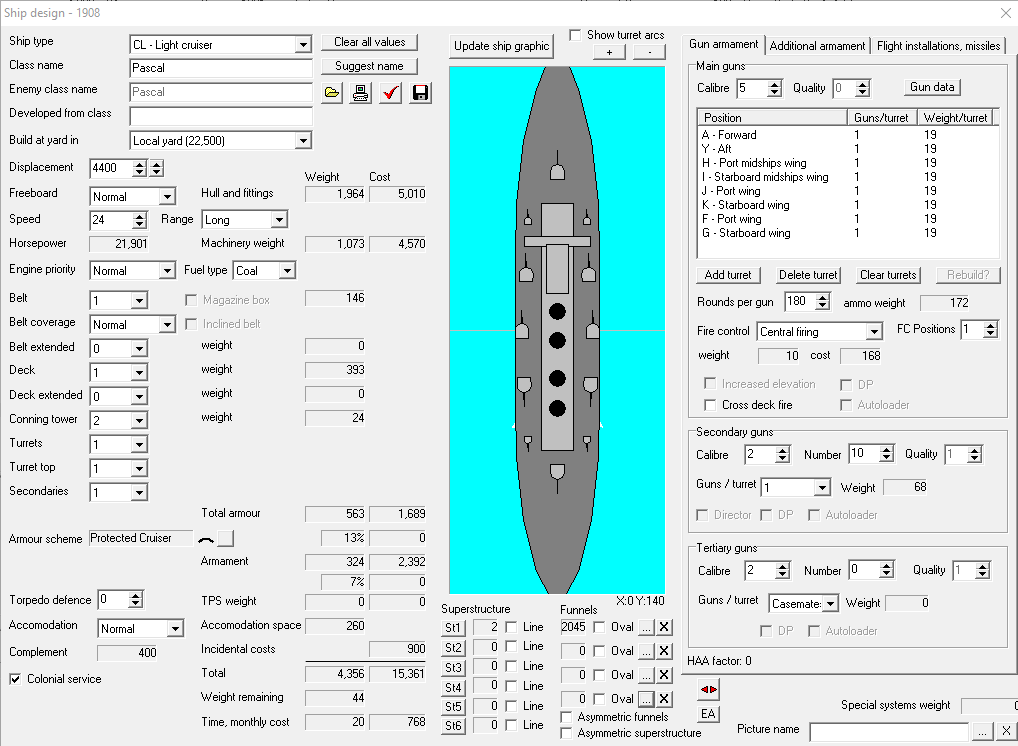 March 1908
March 1908Shipyards lay down the first
Pascal, and our second battlecruiser enters service, with the third due next month.
April 1908Germany's aggressive naval program prompts an event which forces us to lose face or raise tensions. I elect for the former, dropping our prestige from 25 to 24.
May 1908Another pair of
Pistolets enters service, bringing the total to six. The shipyards enter their postwar slumber, building a pair of light cruisers (an
Isly class, named
Lavosier after one of the ships we lost in the war, and
Pascal), and
Devastation.
I don't have time for the full update—it's currently 9:44 p.m. on Wednesday, so I need to wrap up and get all the images ready.
Two-Year Report: DiplomacyMes amis, we bask in the glory of three new colonies, and a Mediterranean increasingly blanketed by the tricolor flag.
Two-Year Report: FinancesWe're at that point now where the fleet we have costs enough to maintain so that the fleet we want is hard to build. Our recently-peacetime monthly budget is 13,071 funds, of which 6,720 funds are eaten up by maintenance, 1,568 by research, and 200 by intelligence. That leaves us around 4,500 to spend on construction, which is not quite two dreadnoughts.
Some ships will probably have to be mothballed or retired going forward, and the
Gueydons overseas are prime candidates. As soon as the new
Pascals start to roll off the ways, the
Gueydons deployed overseas will start coming home, to be stored away for later use or scrapped altogether.
Other candidates include some of our light cruisers—we still have the second-largest light cruiser fleet in the world, behind Britain, although (as I've mentioned before) our light cruisers pull some of the same duties that armored cruisers do in other navies.
Two-Year Report: The FleetWe're in good shape compared to our Mediterranean peers. We have three dreadnought-style ships in service (all
Duquesne battlecruisers) and one dreadnought battleship under construction. Italy and Austria both have dreadnought battleships under construction, one a piece. Another option, one I haven't used much in previous Rule the Waves games, is the reserve fleet option, which halves maintenance costs for ships without much long-term penalty.
Anyway, I have two questions for the gallery:
- Should we make use of the reserve fleet? If so, what should we reserve? One or two battleships? Older light cruisers? Old destroyers? Some combination?
- What should our shipyards focus on? Dreadnought battleships (i.e. 22-knot ships which don't compromise on armor or guns, to the extent possible), or battlecruisers (i.e., 24+-knot ships with respectable armor and fewer or smaller guns, as needed to attain the above)?

 Author
Topic: Vive la France: Let's Play Rule the Waves 2 (Read 37832 times)
Author
Topic: Vive la France: Let's Play Rule the Waves 2 (Read 37832 times)
